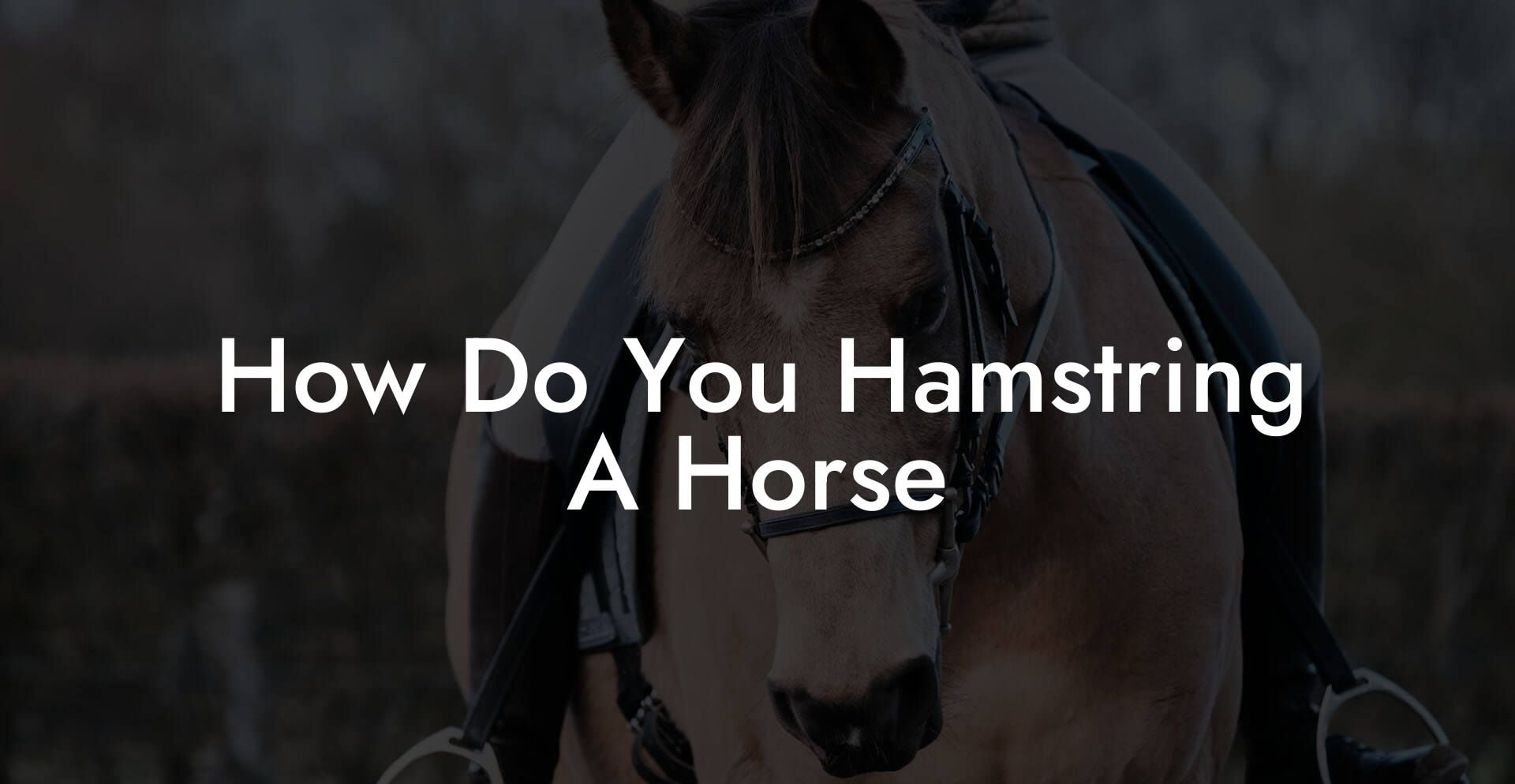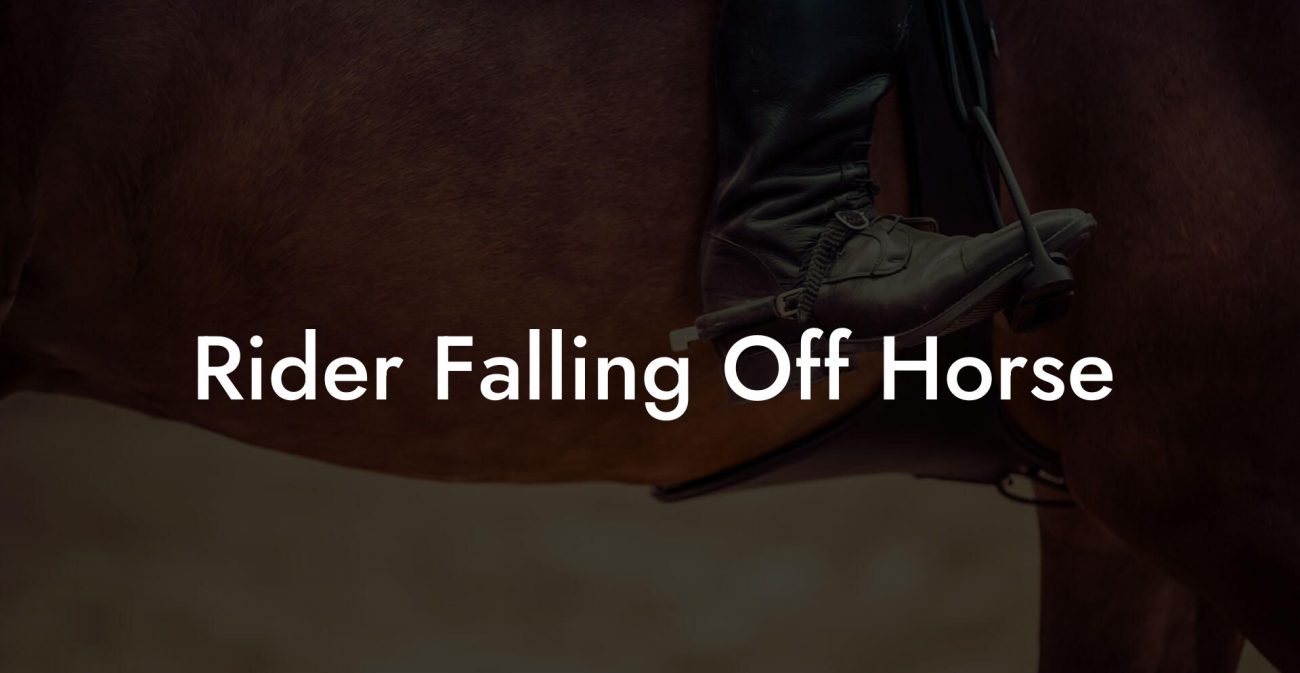Ever wondered what really goes down when it comes to a horse’s powerhouse hindquarters? Whether you're a first-time horse parent or a seasoned equine enthusiast, understanding how to care for a horse’s hamstrings is essential for keeping your majestic steed in tip-top shape. Today, we're diving into the nitty-gritty of equine hamstring care, busting myths, serving up expert tips, and sprinkling in some Gen-Z-approved humor along the way. Get ready to gallop through anatomy lessons, injury prevention strategies, treatment protocols, and all the insider secrets you never knew you needed about your four-legged friend’s behind-the-scenes strength.
Quick Links to Useful Sections
- Unraveling Equine Hamstring Anatomy: What’s in a Muscle?
- Common Hamstring Injuries: The Lowdown on Equine Strains
- Prevention is Better Than a Painful Gallop: Best Practices for Equine Hamstring Care
- Warm-Up is Non-Negotiable
- Consistent Stretching Routine
- Balance is Key
- Proper equipment and Ground Conditions
- Regular Vet Check-Ups and Physiotherapy
- Diagnosis and Assessment: How to Know What’s Going On
- Treatment and Rehabilitation: Getting Your Horse Back on Track
- Holistic and Integrative Therapies: Beyond the Conventional Toolbox
- Equine Acupuncture
- Massage Therapy and Chiropractic Care
- Herbal Remedies and Nutritional Supplements
- nutrition and Exercise: Fueling the Equine Machine
- Anti-Inflammatory Foods for the Win
- Tailored Exercise Plans
- Case Studies: Real-Life Transformations in Equine Hamstring Care
- Case Study 1: Recovering from a Sudden Sprint Mishap
- Case Study 2: Preventive Care in a Competitive Show Jumper
- Case Study 3: Overcoming Chronic Tendonitis through Holistic Interventions
- Creating a Personalized Hamstring Care Plan for Your Horse
- Step 1: Comprehensive Assessment
- Step 2: Set Clear Performance and Recovery Goals
- Step 3: Develop a Multifaceted Routine
- Step 4: Monitor and Adjust
- Resources and Community Support: Your Next Steps
- Equine Hamstring Care FAQs: Your Burning Questions Answered
- Your Journey to Robust Equine Hamstring Health
Unraveling Equine Hamstring Anatomy: What’s in a Muscle?
Before we get into the how-to of hamster, uh, hamstring, care, let’s break down what exactly these muscles are and why they matter. In horses, the hamstring group is a crucial component of the hindlimb, working behind the scenes (and behind the nickname “hamstring”) to power every gallop, canter, and even a casual trot around the pasture.
The equine hindlimb boasts a collection of muscles, tendons, and connective tissues that combine to ensure smooth, powerful movements. Key players include the biceps femoris, semitendinosus, and semimembranosus, yes, these fancy names might sound like spells from a magical equine grimoire, but they’re absolutely real and vital for your horse’s performance.
Think of these muscles as the engine of a high-speed sports car, they provide the burst of power when it’s time to sprint and the stability that keeps your horse balanced when navigating tricky terrain. In other words, strong hamstrings mean a happy horse, while issues in this area can lead to reduced mobility, discomfort, and even long-term performance setbacks.
As you get acquainted with the anatomy of your horse’s hamstrings, you’re also opening the door to understanding common injury patterns and learning how proactive care can keep those muscles firing on all cylinders.
Common Hamstring Injuries: The Lowdown on Equine Strains
Despite all the grace and power on display, even the strongest horses aren’t immune to a few bumps along the way, especially when it comes to their hamstrings. Just like us, horses can suffer from muscle strains, tears, and inflammation that can seriously derail performance if left unchecked.
One of the most common hamstring issues in horses is a muscle strain, which happens when the delicate balance of strength and flexibility is disrupted. Overtraining, sudden bursts of speed, or even uneven terrain can trigger a strain, resulting in inflammation, pain, and a temporary drop in performance.
In more serious cases, horses may suffer from partial or complete muscle tears. These injuries can be caused by an intense workout session, improper warm-up routines, or, in worst-case scenarios, accidents during training exercises. Such injuries not only hamper a horse’s performance but can also lead to time-consuming rehabilitation efforts.
Another issue to be aware of is tendonitis in the hamstring region. While the muscle itself is getting all the glory, the surrounding tendons are equally important. Overuse and repetitive stress can lead to inflammation in these areas, manifesting as stiffness, discomfort, or reluctance to move.
Understanding these common injuries is the first step in being a proactive caretaker. With the right techniques, tools, and treatment strategies, you can help your horse recover quickly, or better yet, prevent these issues from arising in the first place.
Prevention is Better Than a Painful Gallop: Best Practices for Equine Hamstring Care
When it comes to your horse’s hamstrings, prevention is the name of the game. Rather than playing catch-up after an injury strikes, a proactive approach can save you time, money, and a lot of unnecessary stress. Here are some tried-and-true prevention techniques that every equine enthusiast should know:
Warm-Up is Non-Negotiable
Just like hitting the snooze button on a chilly morning, a proper warm-up is crucial for getting your muscles ready for action. A good warm-up increases blood flow, enhances flexibility, and reduces the risk of strains. Whether it’s a brisk walk, some light trotting, or dynamic stretching exercises, a warm-up session of 10-15 minutes sets the stage for a successful workout.
Consistent Stretching Routine
Stretching might seem like a no-brainer, but it’s one of the most overlooked aspects of equine care. Incorporating targeted stretches for the hamstrings into your horse’s daily routine can go a long way in maintaining flexibility and preventing injuries. Think of it as your horse’s version of a morning yoga session, only with a lot more hay involved.
Balance is Key
Overtraining your horse in one area, say, constant sprinting on the track, can lead to imbalances, as some muscles get overworked while others are neglected. A balanced training regimen that incorporates a mix of cardiovascular work, strength training, and rest days not only prevents hamstring injuries but also fosters overall athletic performance.
Proper equipment and Ground Conditions
The right tack and safe footing are critical for preventing injuries. Ill-fitting saddles, improper bridling, or slick ground surfaces can put undue strain on the horse’s muscles. Be sure to invest in quality equipment and check the arena or pasture conditions regularly to ensure a safe workout environment.
Regular Vet Check-Ups and Physiotherapy
Regular check-ups with a veterinarian who specializes in equine sports medicine can help catch issues before they become serious. Additionally, routine physiotherapy or massage sessions can help identify early signs of muscle fatigue or tension, allowing you to adjust your horse’s training plan accordingly.
By following these preventive measures, you’re setting your horse up for long-term, healthy performance. Remember, a little extra time spent on pre-race rituals can mean the difference between a smooth gallop and a painful stumble.
Diagnosis and Assessment: How to Know What’s Going On
Even with the best preventive measures, hamstring injuries can sometimes sneak up on even the most carefully managed horses. When you suspect something might be off, a thorough diagnosis and assessment are your best friends.
The first step in diagnosing a hamstring injury is a careful physical examination. Look out for signs such as uneven gait, reluctance to move, swelling in the hindquarters, or visible heat in the muscle area. If you notice any of these red flags, it might be time to call in the pros.
Veterinarians often use diagnostic tools like ultrasound, MRI, or thermography to get a clear picture of the injury. These technologies allow for a detailed look at the muscle fibers and reveal any tears, inflammation, or other forms of damage that may not be visible to the naked eye.
Once the diagnosis is confirmed, it’s crucial to develop a tailored treatment plan that addresses the specific needs of your horse. This might include rest, targeted physiotherapy, and modifications to your horse’s exercise routine. Communication with your vet is key, ask plenty of questions, and don’t hesitate to seek a second opinion if you’re unsure.
Remember, early detection can be a game-changer. By catching an injury in its early stages, you can minimize downtime and get your horse back in peak condition before any minor issue turns into a major debacle.
Treatment and Rehabilitation: Getting Your Horse Back on Track
When it comes to treating hamstring injuries in horses, there’s no one-size-fits-all answer. Every horse is unique, and so is every injury. The good news is that with modern veterinary science and a little bit of TLC, most horses can make a full recovery and get back to doing what they do best, living their best lives on four legs.
The cornerstone of treatment is the R.I.C.E. method (Rest, Ice, Compression, and Elevation), a strategy that isn’t just for our human athletes but works wonders for equine patients too. Here’s how it breaks down:
- Rest: Give your horse enough downtime to allow the injured muscle to heal. Avoid high-intensity activities until the vet gives the all-clear.
- Ice: Applying cold packs can reduce swelling and numb the pain. Make sure to wrap the ice in a cloth to avoid frostbite.
- Compression: Compression wraps or bandages can help manage swelling and support the muscle during the healing process.
- Elevation: While it might sound like a human concept, elevating the hindquarters (where possible) can aid in reducing fluid accumulation around the injury.
Beyond R.I.C.E., many horses benefit from structured rehabilitation programs that involve physiotherapy, massage, and controlled exercise. Techniques such as hydrotherapy, where your horse exercises in water to reduce load while maintaining mobility, are becoming increasingly popular. Hydrotherapy is like taking your horse to a spa day where the water helps soothe aching muscles and fosters gentle reconditioning.
In cases where the injury is more severe, your vet might consider regenerative therapies such as platelet-rich plasma (PRP) injections or stem cell treatments. These cutting-edge therapies aim to accelerate tissue repair and reduce long-term scar tissue formation, ensuring that your horse can return to full activity sooner.
Importantly, rehabilitation should be seen as a marathon, not a sprint. Gradually reintroducing your horse to rigorous activities, while continually monitoring progress, is vital for ensuring a sustainable recovery. Listen to your equine partner, if they’re showing signs of discomfort, it’s time to ease up, reassess, and adjust the rehab plan.
Holistic and Integrative Therapies: Beyond the Conventional Toolbox
Modern equine care isn’t just about administering injections and prescribing rest days, many horse owners are turning to holistic and integrative therapies to complement conventional treatments. These approaches combine the best of modern veterinary science with time-honored natural remedies to support overall muscle health and recovery.
Equine Acupuncture
Acupuncture has long been used to treat a variety of physical ailments in horses. By targeting specific pressure points, acupuncture is believed to stimulate blood circulation, reduce inflammation, and promote healing, not just in the hamstrings, but across the entire muscular system.
Massage Therapy and Chiropractic Care
Regular massage therapy can help release muscle tension, improve circulation, and increase flexibility. Many horse owners swear by equine massage as a way to maintain performance levels and prevent injuries before they happen. Some even combine our favorite therapy with chiropractic adjustments to ensure the skeletal alignment is optimal, which in turn supports the overall functioning of the muscles.
Herbal Remedies and Nutritional Supplements
Mother Nature has a few tricks up her sleeve when it comes to muscle care. Equine herbal supplements, featuring ingredients like turmeric, boswellia, and omega-3 fatty acids, are increasingly popular for their anti-inflammatory properties. These supplements can be seamlessly added to your horse’s daily diet, working from the inside out to support muscle repair, reduce inflammation, and promote overall wellbeing.
Integrative therapies are all about creating a holistic care package for your horse. When combined with traditional treatments, these natural remedies can accelerate recovery, enhance muscle performance, and even help ward off future injuries.
nutrition and Exercise: Fueling the Equine Machine
Just as a smartphone can’t run on 1% battery, your horse’s performance depends on proper nutrition and a balanced exercise regimen, especially when it comes to those hamstring muscles.
A nutrient-rich diet plays a pivotal role in muscle recovery and overall health. Quality forage, balanced grains, and targeted supplements will ensure your horse has all the building blocks necessary to repair muscle fibers and build strength. Think of it as curating a bespoke meal plan, where every bite contributes to your horse’s athletic prowess.
Anti-Inflammatory Foods for the Win
Incorporate plenty of anti-inflammatory foods into your horse’s diet to combat muscle soreness and support healing. Ingredients like omega-3 enriched feeds, antioxidant-rich fruits, and even specific herbal infusions can work wonders. If your horse could swipe right on a meal, it would be a perfectly balanced plate designed to reduce inflammation and boost recovery.
Tailored Exercise Plans
Whether you’re managing a recovery program or simply maintaining peak performance, structured exercise is critical. A well-rounded routine might include:
- Controlled Warm-Ups: Start slow and steady to prepare the muscles for activity.
- Interval Training: Short bursts of speed interspersed with rest can build power without overtaxing the hamstrings.
- Cool-Down Sessions: Just as important as the warm-up, a cool-down helps prevent muscle stiffness and promotes recovery.
The key here is balance, ensuring your horse gets enough activity to stimulate muscle strength while not overworking an already vulnerable area. Much like a well-crafted playlist that blends intense beats with chill vibes, a balanced exercise regimen keeps your horse’s muscles humming in harmony.
Case Studies: Real-Life Transformations in Equine Hamstring Care
Real-world examples are where science meets heart. Let’s explore a few inspiring case studies that highlight how integrative hamstring care can make a dramatic difference in the lives of equine athletes.
Case Study 1: Recovering from a Sudden Sprint Mishap
Meet Blaze, a spirited thoroughbred renowned for lightning-fast sprints. During a particularly intense training session, Blaze suffered a moderate hamstring strain that threatened to derail his racing career. His dedicated team immediately implemented a tailored recovery protocol, starting with strict rest, followed by the R.I.C.E. regimen and a gradual reintroduction of controlled exercise.
Complementing conventional treatment, Blaze’s caregivers integrated acupuncture sessions and regular massage therapy into his routine. Adding in anti-inflammatory supplements and a specialized nutritional plan, Blaze’s journey from injury to recovery became a textbook example of integrative hamstring care done right. Within months, Blaze was back on track and performing with the vigor of his pre-injury self.
Case Study 2: Preventive Care in a Competitive Show Jumper
Luna, a prized show jumper, was known for her impeccable form and agility. However, with a busy competition schedule, her hamstrings were constantly at risk due to overtraining. Luna’s team adopted a comprehensive preventive regime that focused on daily stretching, regular massage therapy, and routine physiotherapy check-ups.
They also invested in high-quality ground surfaces for training and experimented with hydrotherapy sessions to reduce muscle load. Luna’s proactivity paid off, she not only maintained peak performance but also avoided any serious hamstring injuries throughout the season.
Case Study 3: Overcoming Chronic Tendonitis through Holistic Interventions
For Rocky, a seasoned dressage horse with a history of recurring hamstring tendonitis, the journey to recovery was a long one. After numerous episodes of swelling and discomfort, Rocky’s veterinarian recommended a holistic treatment plan that encompassed a blend of conventional therapies and alternative remedies.
The regimen included targeted physiotherapy, regular chiropractic adjustments, and the incorporation of natural anti-inflammatory supplements derived from herbal sources. Over time, Rocky’s symptoms steadily diminished, and his overall performance improved. His journey serves as a testament to the power of integrative care in managing chronic conditions.
Creating a Personalized Hamstring Care Plan for Your Horse
No two horses are identical, and neither are their hamstring care needs. Creating a personalized care plan ensures that every aspect of your horse’s wellbeing is considered, from daily nutrition and exercise to specialized interventions when needed. Here’s a step-by-step guide to help you craft the perfect plan:
Step 1: Comprehensive Assessment
Begin by scheduling regular check-ups with your equine veterinarian or physiotherapist. Discuss your horse’s training regimen, any previous injuries, and subtle signs of potential discomfort. A detailed assessment, possibly incorporating diagnostic imaging, will serve as the foundation for your personalized plan.
Step 2: Set Clear Performance and Recovery Goals
What do you want to achieve? Whether it's enhancing performance, shortening recovery time, or simply maintaining overall health, defining clear and achievable goals will help guide your approach. Write these goals down and use them as a benchmark to evaluate progress over time.
Step 3: Develop a Multifaceted Routine
The best plans integrate conventional treatments with innovative, holistic interventions:
- Structured Exercise: Design a routine that balances high-intensity workouts with gentle stretching and cool-down periods.
- Preventive Measures: Incorporate warm-ups, regular stretches, and monitoring of surface conditions.
- Rehabilitative Practices: When injuries occur, use the R.I.C.E. method, and consider physiotherapy, acupuncture, or massage therapy as needed.
- Nutritional Strategy: Ensure your horse’s diet is rich in anti-inflammatory foods, lean proteins, and essential nutrients that support muscle repair.
Step 4: Monitor and Adjust
Recovery and performance are ongoing journeys. Keep a detailed log tracking your horse’s exercise routines, dietary changes, and symptoms. Regular consultation with your vet or equine specialist will help you fine-tune the plan and make adjustments based on your horse’s progress.
A personalized plan is dynamic, it evolves as the needs of your horse change over time. Stay engaged, be proactive, and always trust your instincts when it comes to your horse’s health.
Resources and Community Support: Your Next Steps
Caring for a horse isn’t a solo journey. Whether you’re managing a minor muscle strain or rehabilitating a serious injury, the resources and support available can make all the difference in your horse’s recovery. Here are some tips on how to tap into a supportive community:
Network with Equine Professionals: From farriers to specialized equine veterinarians and physiotherapists, building relationships with experts in the field can provide invaluable insights. Don’t be shy, ask questions, join workshops, and attend seminars to stay on top of the latest in equine care.
Online Forums and Social Media Groups: There’s a thriving online community dedicated to equine health. Join Facebook groups, follow Instagram influencers, and subscribe to equine care forums that share success stories, advice, and the latest research. These communities are goldmines for sharing experiences and picking up tips that might just save you and your horse from a potential mishap.
Workshops and Clinics: Many equine centers hold regular workshops on topics ranging from injury prevention to advanced rehabilitation techniques. Attending these sessions not only builds your knowledge base but also connects you with like-minded individuals who share your passion.
Literature and Research Papers: Stay informed by reading up on the latest veterinary research and care guidelines. Whether you’re poring over academic journals or tuning into podcasts by equine experts, knowledge is your best tool in maintaining your horse’s peak performance.
Tapping into these resources will help guide your decisions and empower you to take charge of your horse’s hamstring care, and overall health. The journey is continuous, but with the right support network, you’re never truly alone on the trail.
Equine Hamstring Care FAQs: Your Burning Questions Answered
We know you have questions swirling around like autumn leaves in a brisk wind, so here are some frequently asked questions about equine hamstring care, complete with straightforward answers:
1. What exactly are a horse’s hamstrings, and why are they important?
The hamstrings in horses refer to the group of muscles at the back of the hindlimb, including the biceps femoris, semitendinosus, and semimembranosus. They are essential for powering movements like gallops, canters, and jumps, while also providing balance and stability.
2. How can I tell if my horse is suffering from a hamstring injury?
Look for signs such as limping, reluctance to engage in strenuous activity, noticeable swelling, or heat in the hindquarters. Behavioral changes during exercise may also indicate discomfort in the hamstring region.
3. What preventive measures can I take to protect my horse’s hamstrings?
Emphasize proper warm-up routines, regular stretching, balanced training regimens, and safe footing. Regular check-ups with an equine vet and physiotherapist further ensure early detection of potential issues.
4. Is the R.I.C.E. method effective for treating hamstring injuries in horses?
Yes, the R.I.C.E. method (Rest, Ice, Compression, and Elevation) is widely recommended as the first line of treatment for minor strains and injuries. It helps to reduce inflammation and promote healing.
5. How long does it typically take for a horse to recover from a hamstring injury?
Recovery time varies depending on the severity of the injury. Minor strains may heal within a few weeks, while more severe injuries could require several months of rehabilitative care.
6. What role does nutrition play in hamstring recovery?
Nutrition is critical. A diet rich in anti-inflammatory foods, lean proteins, and essential vitamins helps support muscle repair and boosts the overall healing process.
7. Can alternative therapies like acupuncture or massage really help my horse?
Absolutely. Many horse owners have reported significant improvements in muscle flexibility and reduced pain levels when incorporating acupuncture, massage therapy, and other holistic approaches into their routine.
8. How can I create a balanced training program that minimizes the risk of hamstring injuries?
Work with an equine sports specialist to design a regimen that combines warm-up, interval training, and cool-down periods, while also scheduling regular rest days and varying the intensity of workouts.
9. Are there specific supplements that aid in equine muscle recovery?
Yes, supplements such as omega-3 fatty acids, turmeric, and herbal anti-inflammatories can support muscle health and facilitate recovery, though you should always consult with a veterinarian first.
10. How do I know when my horse is ready to return to full activity?
Regular veterinary assessments, monitoring of muscle strength, and gradual reintroduction to exercise are key. Patience is essential, rushing the process can lead to re-injury.
Your Journey to Robust Equine Hamstring Health
Caring for your horse’s hamstrings isn’t just about injury prevention, it's about nurturing a balanced, performance-ready animal that can continue to dazzle you with every canter and gallop. This holistic approach, blending modern veterinary practices with time-tested holistic remedies, ensures that your horse not only recovers from setbacks but truly thrives.
Embrace the power of proactive care: educate yourself about equine anatomy, implement preventive routines, and never hesitate to lean on the expertise of professionals in the field. Every massage, every carefully considered adjustment in your horse’s training or diet, contributes to a bigger picture of sustained health and vitality.
Your journey together, filled with challenges, triumphs, and plenty of equine-inspired dad jokes, is a testament to the bond you share with your horse and your commitment to excellence in care. Keep learning, stay engaged, and always be curious. With proactive management and a touch of holistic wisdom, you can ensure that your horse’s hamstrings remain strong, resilient, and ready for anything.
So, next time you see your horse stretching out in the pasture or powering down the track, smile knowing that you’re armed with the knowledge and tools to keep those hamstrings in peak condition. Here’s to many more miles of smooth rides and joyous gallops!













